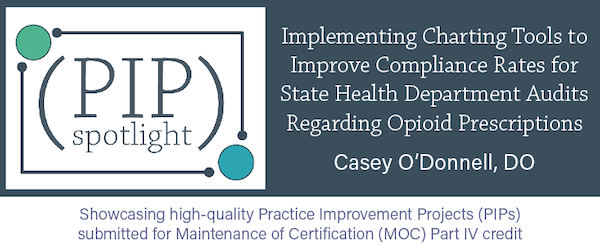CC
PIP Spotlight: Implementing Charting Tools to Improve Compliance Rates for State Health Department Audits Regarding Opioid Prescriptions

Dr. Casey O’Donnell, the medical director for a state-registered pain management clinic, submitted the Practice Improvement Project featured in the October PIP spotlight. Dr O’Donnell implemented a chart-review process and chart templates to assist physicians at his clinic in reaching compliance with Florida state laws on chart documentation for opioid medication prescriptions.
The PIP Spotlight is a periodic feature on News Center to highlight exemplary Practice Improvement Projects submitted by your fellow diplomates for Maintenance of Certification (MOC) Part IV credit.
Diplomates can use projects featured in the PIP Spotlight as models for their own PIPs as well as to learn about other diplomates doing similar work.
Thanks for your submission, Dr. O’Donnell!

What is the problem you are trying to solve?
The chart note for every patient being prescribed an opioid analgesic must contain specific language to be in compliance with Florida state law. Prior to this project, the charts were not audited by staff to ensure that the necessary documentation was included, thereby risking fines and disciplinary action for both the clinic and physicians, which could disrupt patient care.
What data (objective measurements) do you have that supports this as a problem?
In the first quarter of 2018, our office manager performed a random audit of 10 charts from each physician. The results of the audit showed that neither of the physicians in the practice reached 100% compliance with their documentation. One physician was at 80% and the other was at 0%.
What is your opportunity statement? State the goal you hope to achieve.
Chart documentation of specific language must be in every patient encounter in which an opioid medication is prescribed to be compliant with Florida state law. The internal chart review revealed that none of the physicians in the practice had 100% compliance with the required documentation prior to the implementation of the templates. The goal of the project was to reach 100% compliance by the end of the second quarter of 2018.
What is the underlying cause of the performance/quality problem?
The results of the internal audit were discussed at a monthly division meeting with the physicians, and the underlying cause was determined to be a combination of different factors:
- Unfamiliarity with the requirements of the law
- Difficulty documenting the required text into the electronic health record (EHR)
- Distraction from recording the required documentation when focusing on patient needs during a busy clinic day

What change(s) did you implement?
I created templates which can be attached to patients' charts in the EHR, depending on the specific situation. I placed the templates in each of the physician's EHR profiles in a folder of their choosing. Each of these templates specifically addresses a facet of the law or patient safety recommendation and is required for both patient safety and compliance.
In addition, it was also agreed that patients on long-acting or high-dose (>50 meq morphine) opioid analgesics, those receiving intrathecal opioids, and those at high risk for misuse should also be prescribed naloxone as a patient safety measure.
Templates include:
Template 1
The patient was educated on the risks of respiratory suppression and death when using opioid-based analgesics in conjunction with a benzodiazepine. I reminded them not to take the medications at the same time and highly encouraged the patient to seek alternative treatment options.
Template 2
Per the CDC chronic opioid use guidelines, the patient is being prescribed long-term opioid medication because of an underlying pathological medical condition which cannot be cured and has failed to improve despite other treatments, and therefore the treatment is considered palliative in nature.
Template 3
Due to the potential risk of respiratory suppression and death associated with an overdose of opioid medications, the patient was provided a prescription for naloxone. The signs and symptoms of opioid overdose were also discussed with the patient, and it was strongly recommended that the patient communicate the location of the naloxone to a family member or companion in case of an overdose.
Template 4
My previous office note, including the assessment and plan sections, was reviewed and used to help formulate today's treatment plan.
Template 5
The patient was prescribed a greater than 72-hour supply of opioid medication for their chronic, nonmalignant pain as they have otherwise failed conservative treatment and will be regularly evaluated for alternative treatment options and monitored for signs of aberrant behaviors. In addition, the patient has a signed controlled substances contract on file with this practice.
Template 6
The patient’s symptoms have remained stable, there have not been any aberrant behaviors noted, and he/she is able to perform their activities of daily living (ADLs) without hindrance from pain and without bothersome side effects. Because of this, I will see him/her in three months.
Template 7
The patient submitted a sample today for a urine drug screen. This was conducted to ensure compliance with the treatment plan, compliance with the practice's "Narcotic Medication Agreement," to assess for any aberrant behavior, and to help assess the risk of prescribing the patient-controlled substances. A query was also performed of the state prescription database today to evaluate for aberrant prescription medications.

Did you achieve your goal or target from your opportunity statement? What data do you have to support your conclusion?
Yes, the goal was reached. At the most recent division meeting, another random chart audit was performed, and all physicians were in 100% compliance with the documentation requirements.

Will you continue with the changes you have implemented?
Since the templates were successful in keeping the physicians in compliance with Florida state law, the current plan is to continue with the templates and modify them as needed to stay in compliance with documentation requirements. In addition, naloxone continues to be prescribed regularly for the patients who meet the aforementioned criteria.



